10 Best Software Tools for Enterprise Feedback Management
Last updated on Tue Jan 14 2025
Many organizations experience difficulty in managing feedback. The bigger the organization and the more customers you have, the more complex the operations, as you have to manage thousands of pieces of feedback coming from different sources. However, Enterprise Feedback Management Software can help you with that!
In today’s evolving and competitive business landscape, there is a wide range of enterprise feedback management software tools. Choosing the right tool can enhance product quality, improve the customer experience, and boost business growth.
The overall enterprise software market is predicted to reach $315 billion this year. To capture more market share, you need to develop the best product possible based on user feedback.
Keep reading for a list of enterprise feedback tools, best practices, and FAQs.
What Is Enterprise Feedback Management (EFM)?
Enterprise Feedback Management (EFM) is a system that helps an enterprise or organization collect, analyze, manage, and act on feedback. The feedback can come from various sources, including customers, employees, teams, and stakeholders across multiple channels.
Enterprise Feedback Management collects valuable insights from different feedback loops, identifies customer pain points, and areas of improvement, and evaluates customer satisfaction levels. It also provides actionable insights on how to improve customer loyalty, and engagement, and reduce churn rate.
What Makes Enterprise Feedback Management Different?
Enterprise Feedback Management (EFM) does not just collect feedback; it turns it into actionable insights. It is different from other methods of collecting and analyzing data based on the following:
1. The Scale and Scope
An enterprise is a large-scale organization that is involved in a complex network of operations. It is big and complex and has more customer data.
In EFM, there are multiple sources (e.g., customers, employees, stakeholders, teams) to gather feedback from (e.g., surveys, websites, social media). This system can accommodate a large volume of data.
2. The Integration
Enterprise Feedback Management is a centralized feedback platform. It manages all feedback on a single platform. No matter the number of feedback sources, every piece of feedback is gathered in one location.
There are EFM tools that collect feedback from all sources, manage and prioritize it, and determine which feedback has more valuable insights.
3. Strategic Alignment
Another characteristic that makes EFM different is the power to strategically align. It aligns feedback with the overall organizational goals, drives product innovation, and increases customer engagement and satisfaction.
4. Advanced Analytics
Unlike feedback tools for smaller companies that provide basic analytics, EFM offers advanced and sophisticated analytics. It allows you to conduct customer segmentation, predictive analysis, natural language processing, and feedback analysis, and identify trends.
No matter the volume of data, you can uncover actionable insights.
5. Workflow Automation
Enterprise Feedback Management automates response workflow and prioritizes issues based on urgency. It helps analyze large data volumes so that you can gain access to the most valuable insights.
It also streamlines the process of collecting, managing, and acting on feedback.
10 Best Enterprise Feedback Management Software Tools
EFM gives organizations actionable insights for the enhancement of their product and customer experiences. The following are the best feedback tools you can use.
1. Frill
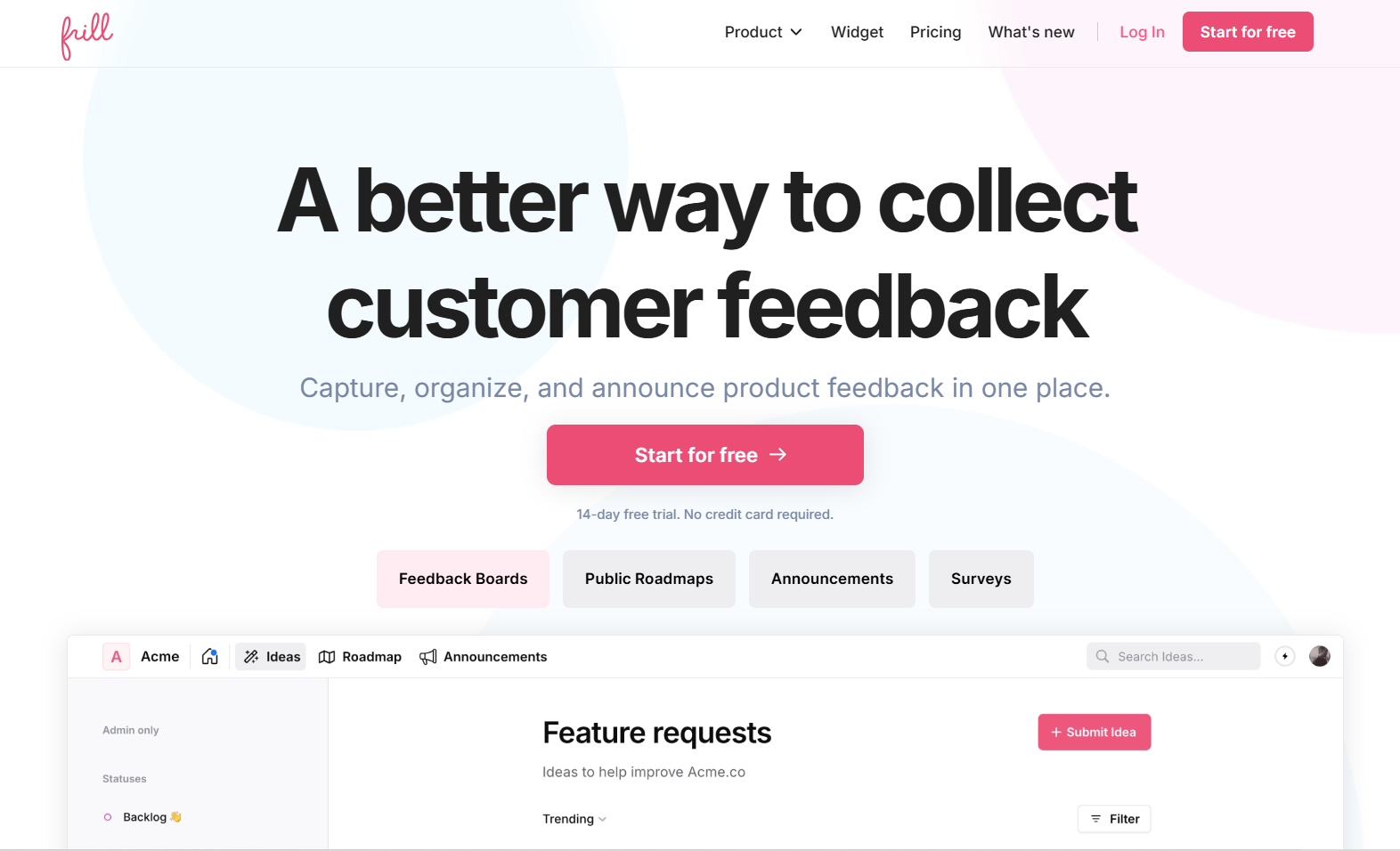
This is a product feedback and public roadmapping tool that you can use to collect feedback via idea boards and embedded widgets, assess and prioritize feedback, communicate upcoming work to users, and announce new features via release notes.
Frill allows you to streamline your workflow for collecting and implementing feedback. Product managers can communicate directly with their users and rely on feature voting for prioritization.
Features:
Idea Board
Feedback status and sorting
Feedback statuses and sorting
Embeddable widget
Public roadmap
Announcements
SSO for users
Whitelabelling
Feature upvoting for prioritization
User comments
User notifications
Pricing:
Frill offers a low-cost plan for just $25 per month, giving you up to 20 ideas on a board. Or you can sign up for the $149-per-month Growth plan and unlock all features and unlimited ideas.
2. Featurebase
This tool is best for large-scale companies that have a big customer base and collect large volumes of feedback. Featurebase makes data collection, analysis, and prioritization easy. It provides actionable insights for enhanced product quality.
Some of the Best Features Include:
A centralized platform for all feedback (internal and external)
In-app
Revenue-focused feedback prioritization
Connect customer data to their feedback
Public and private product roadmaps
Bug report tracking
Customer surveys (NPS, CSAT, etc.)
Prioritization frameworks
Customer segmentation
Custom domain
integrations
And much more.
Affordable Pricing:
Starter Plan ($49/month): 4 members
Growth Plan ($99/month): 6 members
Business Plan ($207/month): 8 members
Enterprise Plan (custom): unlimited members
All plans let you collect unlimited feedback, and you can try them with a 10-day free trial.
3. Aha!
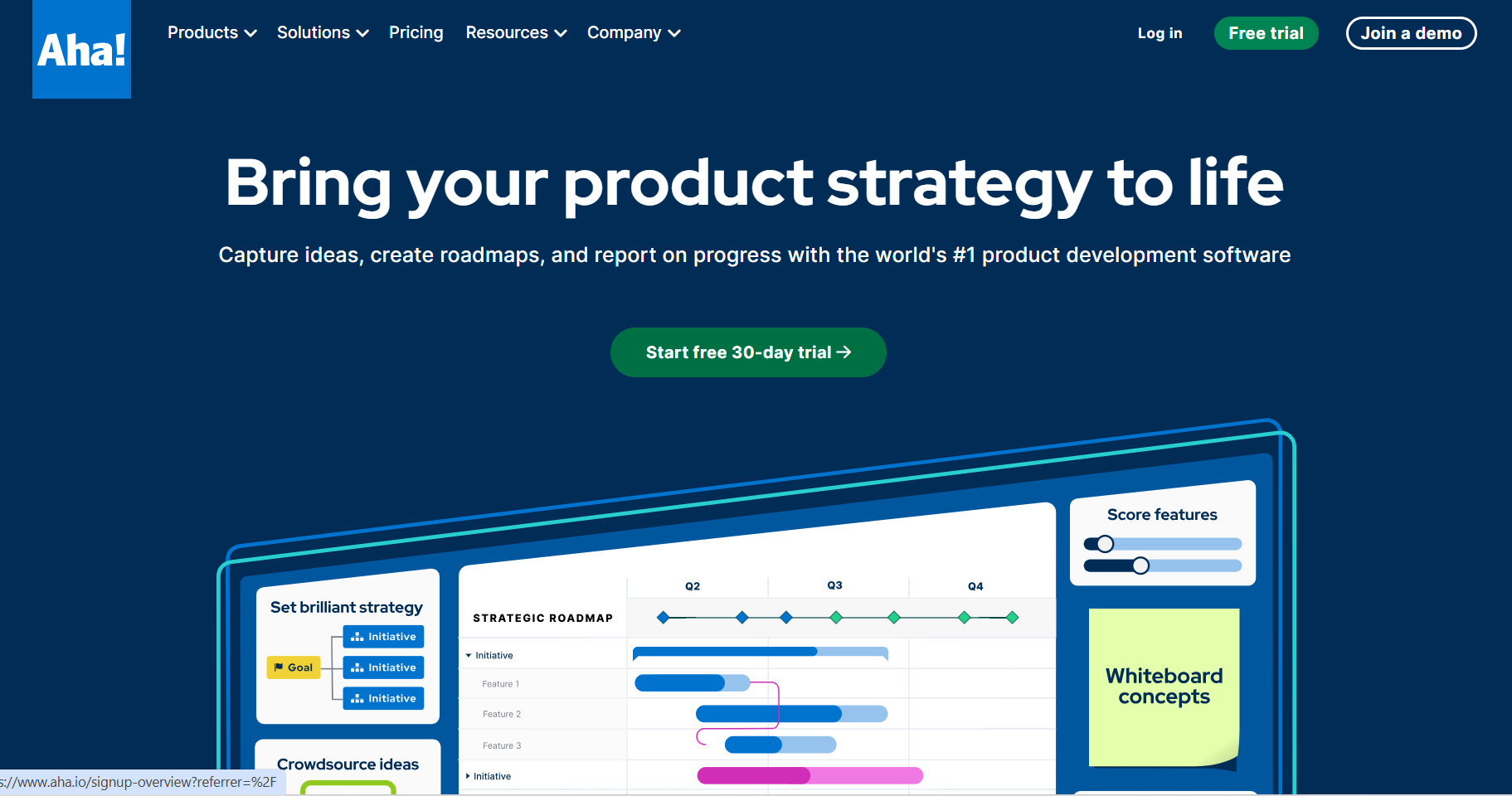
Aha! is more of a general and comprehensive product tool for streamlining product strategy and development processes. It can be used for defining features, setting roadmaps, collecting and managing feedback, prioritizing tasks, and more.
The Features Are:
Roadmap creation
Roadmap management
Customer feedback collection and management
Idea and task prioritization
Integration capacities
Develop a platform for agile product development
Whiteboards for visualizing product information
Knowledge platform for publishing product information
Pricing:
Roadmaps (starts at $59 per user/month)
Ideas (starts at $39 per user/month)
Whiteboards (starts at $9 per user/month)
Knowledge (starts at $39 per user/month)
Develop (starts at $9 per user/month)
3. Productplan
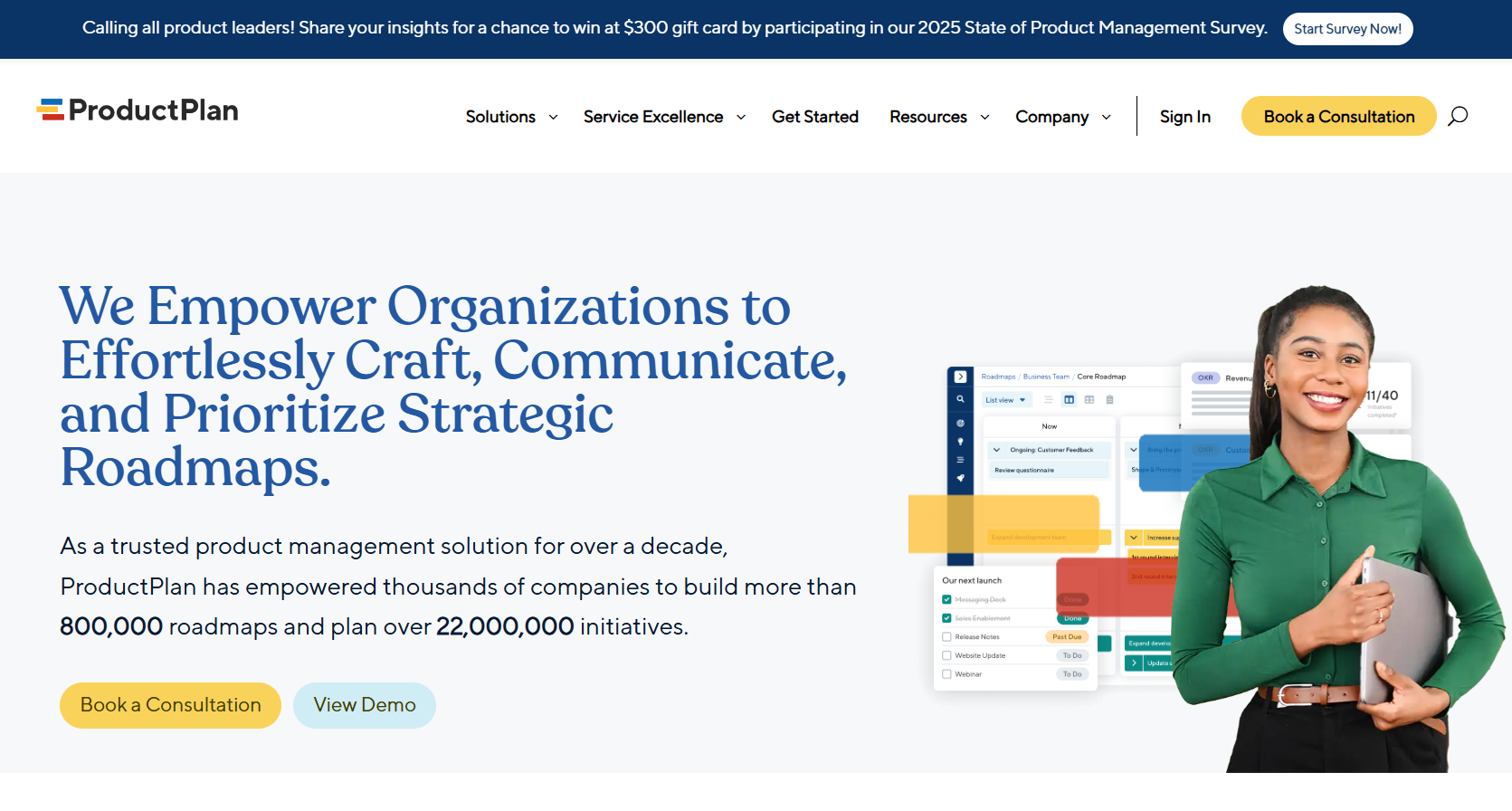
This is an enterprise feedback management tool for product planning, roadmap creation and management, product workflow creation, etc. Productplan is not just a mere tool for feedback collection and management.
The Features Are:
Product feedback strategy management
Task and backlog prioritization
Public and private roadmaps
Integrations
Productplan does not display pricing on its website. You will have to book a consultation meeting to get a personalized quote. There is also no free trial available.
4. Uservoice
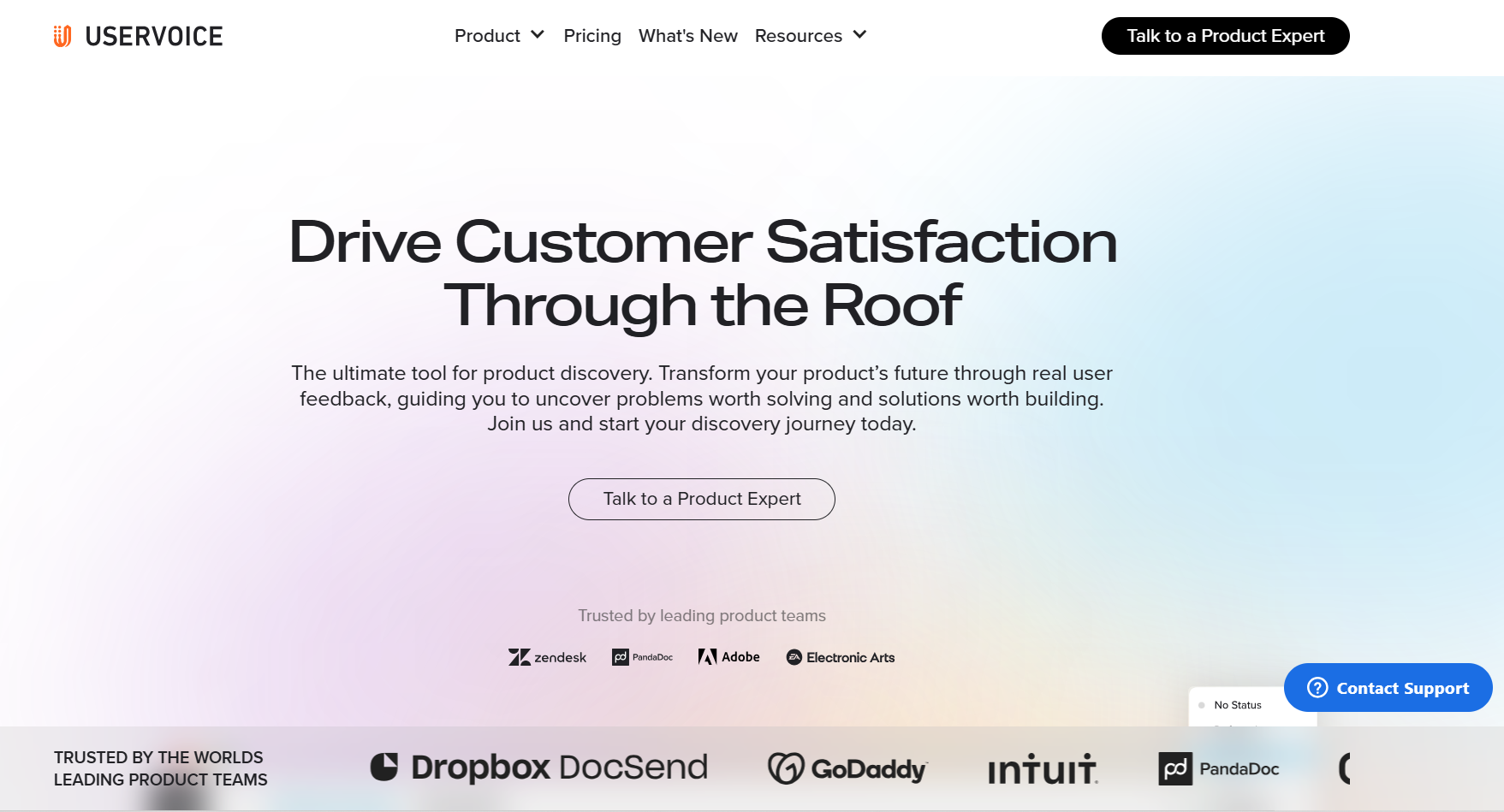
Uservoice is one of the best enterprise feedback management tools for gathering customer insights from various channels. It not only collects feedback, but it also pinpoints opportunities to improve customer satisfaction levels and provide actionable insights.
It also transforms customer feedback into meaningful product enhancements.
Features:
Customer feedback segmentation
Feature prioritization
Feedback collection from various channels
Integrations
Constant system monitoring
Feedback forums, analysis, and prioritization
Roadmap prioritization
Advanced analytics
Customer engagement features
Product research features
Pricing:
The cheapest plan is $899 per month for 1,000 active users. Additionally, you have to sign an annual contract since there are no monthly plans available. There is no free trial available, and you can learn more about the product by scheduling a demo with their team.
5. Bettermode
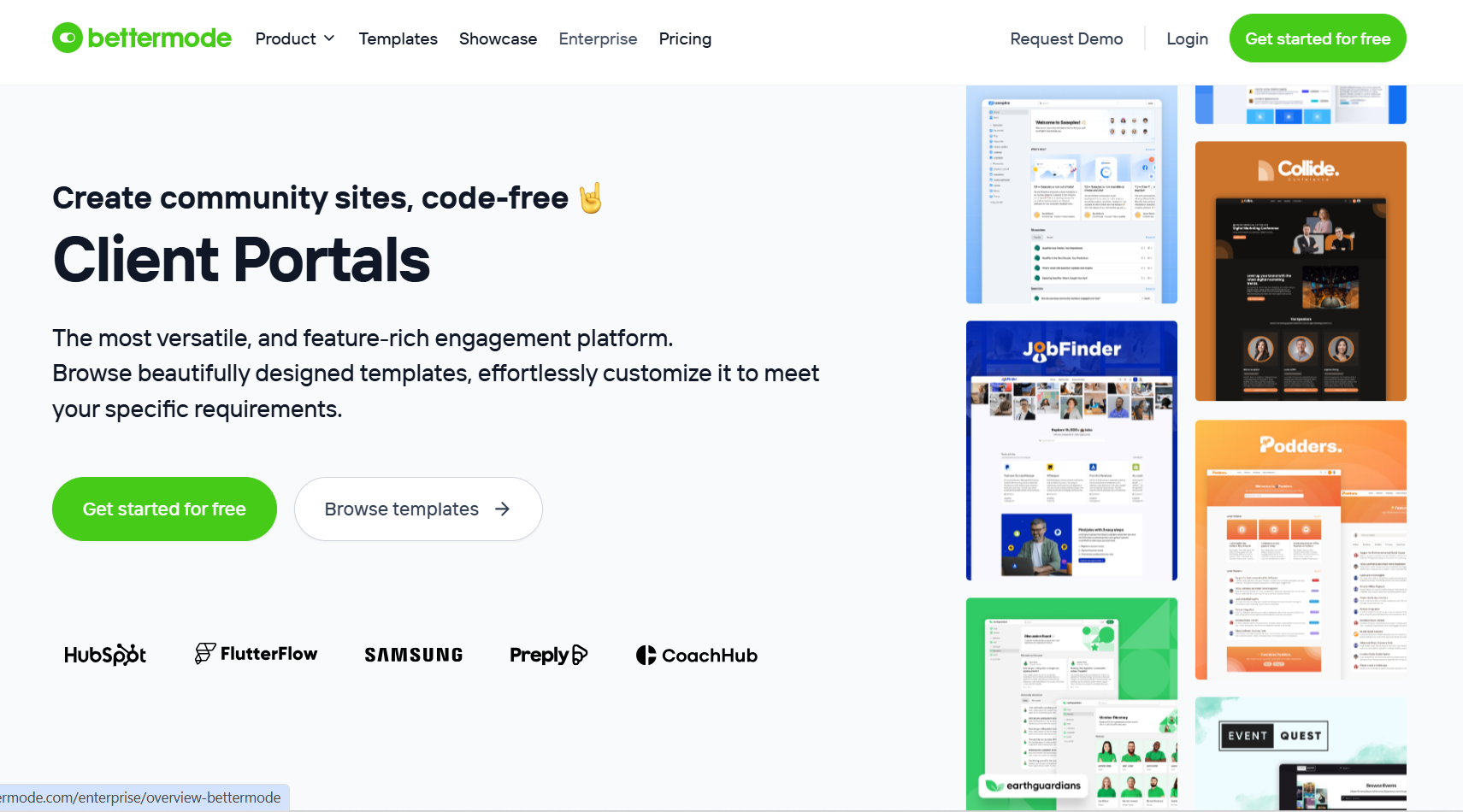
This EFM tool is a remarkable tool for collecting, managing, analyzing, and acting on feedback. It also helps to increase customer engagement on your website.
Features Include:
Centralized feedback platform
Feedback prioritization
Status update for existing customers
Customer leaderboard and badges
There is a free plan, but it only allows up to 10 members. The Lite plan is $19, which includes unlimited users and a custom domain with three collaborators.
6. Userback
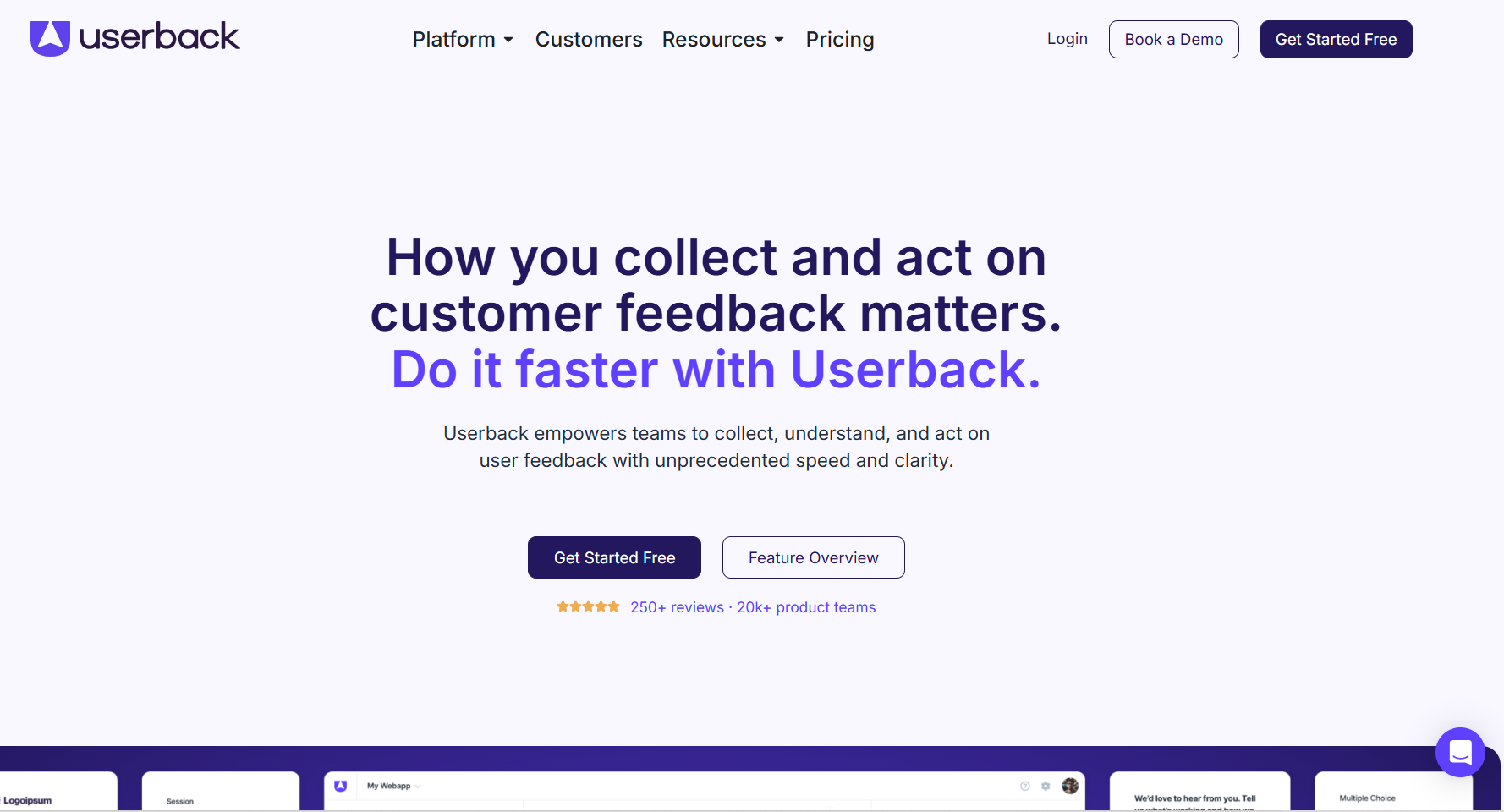
Userback collects, analyzes, manages, and acts on feedback. It has a wide range of features.
Userback Features Are:
Feedback widgets
Customer surveys
Video recording
Browser extension
Roadmaps
Feedback management
Screen annotations
User identification
Paid plans start at $49 per month, which includes access to five users on your team. A free trial is also available.
7. Canny
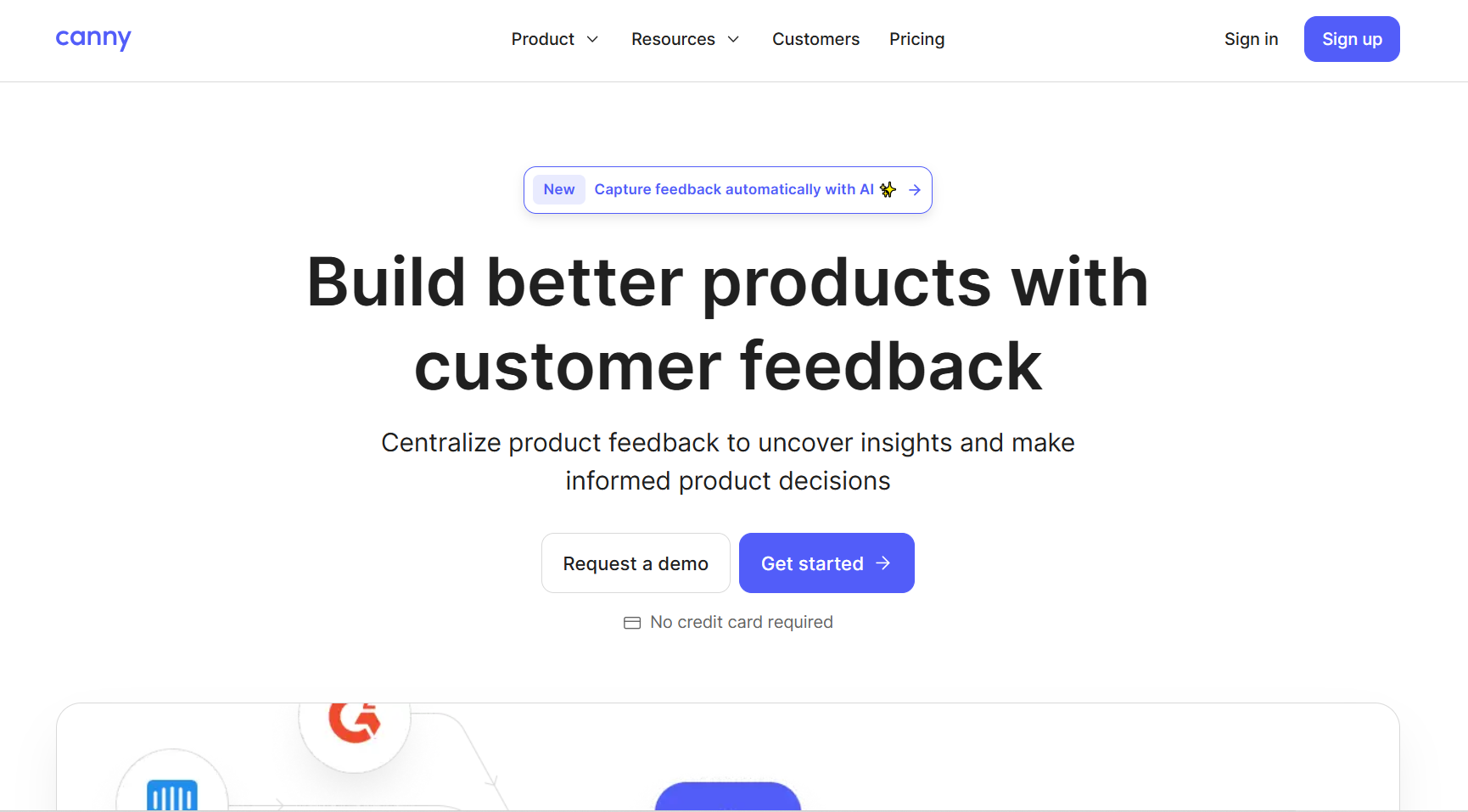
Canny is an enterprise feedback management tool for product development and management. With its numerous features, you can collect, analyze, understand, and act on feedback.
The Features Include:
Feedback collection, analysis, and prioritization
Feedback management
Roadmap creation and management
Feature request management
Public roadmaps
Integration
Pricing:
Paid Canny plans start at $79 per month, but you only get the most valuable features in the priciest plan, at $359 monthly. A free plan is also available.
8. Prodpad
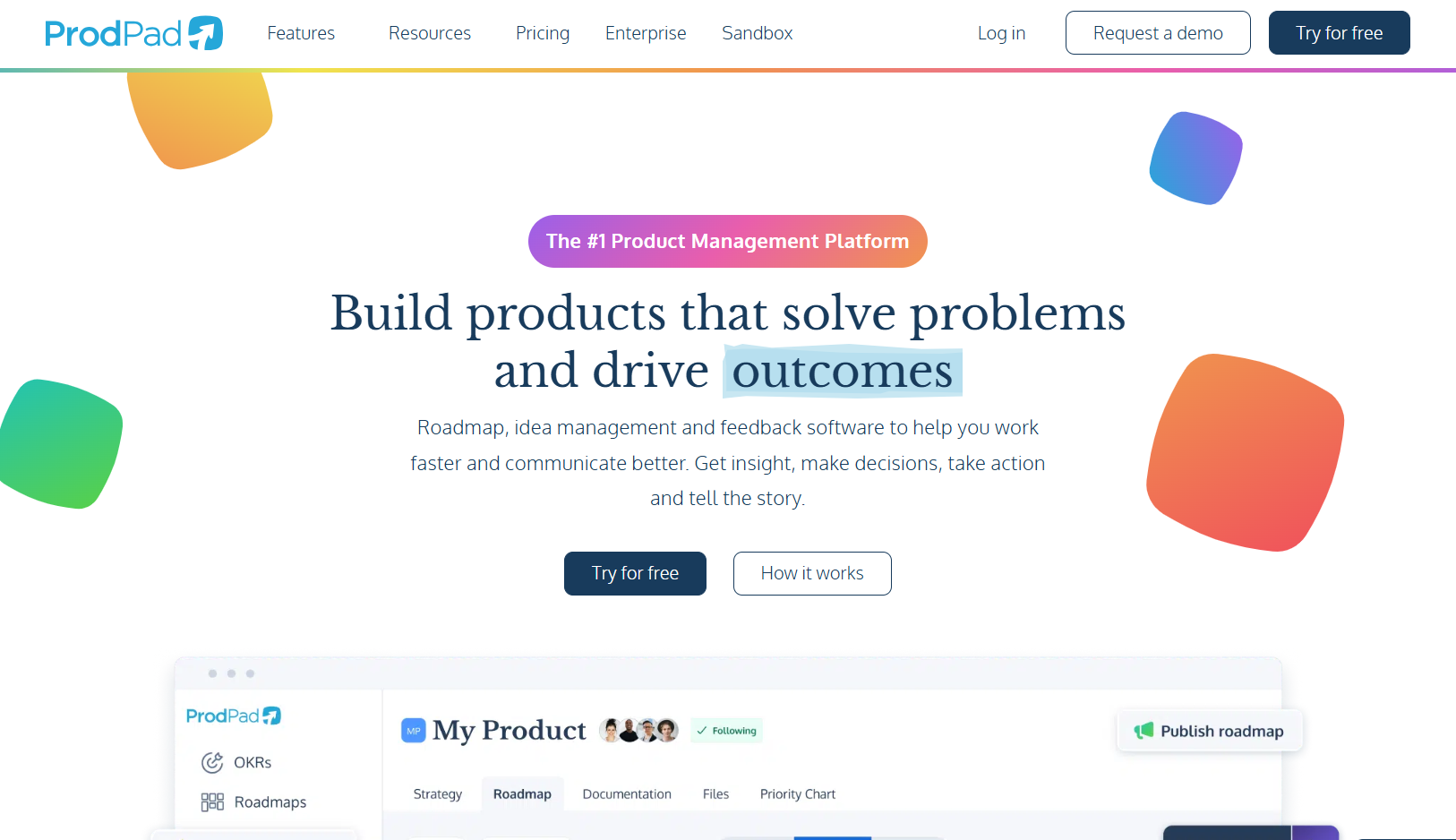
Prodpad is another top enterprise feedback management tool. It has many features that help customer support, product, sales, and marketing teams.
Main ProdPad features include:
Product roadmaps
Idea management
Feedback management
Product backlog workflow creation and management
Team collaboration features
ProdPad's pricing plan is a bit more complex than the rest of the tools on this list. The main product is split up into three pricing tiers:
Roadmaps
Ideas
Feedback
As their name suggests, each one offers a portion of the enterprise feedback management software features of Prodpad. Each of the three tiers starts at $24 per user per month, which means you'll need $72 minimum to get the full Prodpad experience.
The free 7-day trial is available.
9. Qualaroo
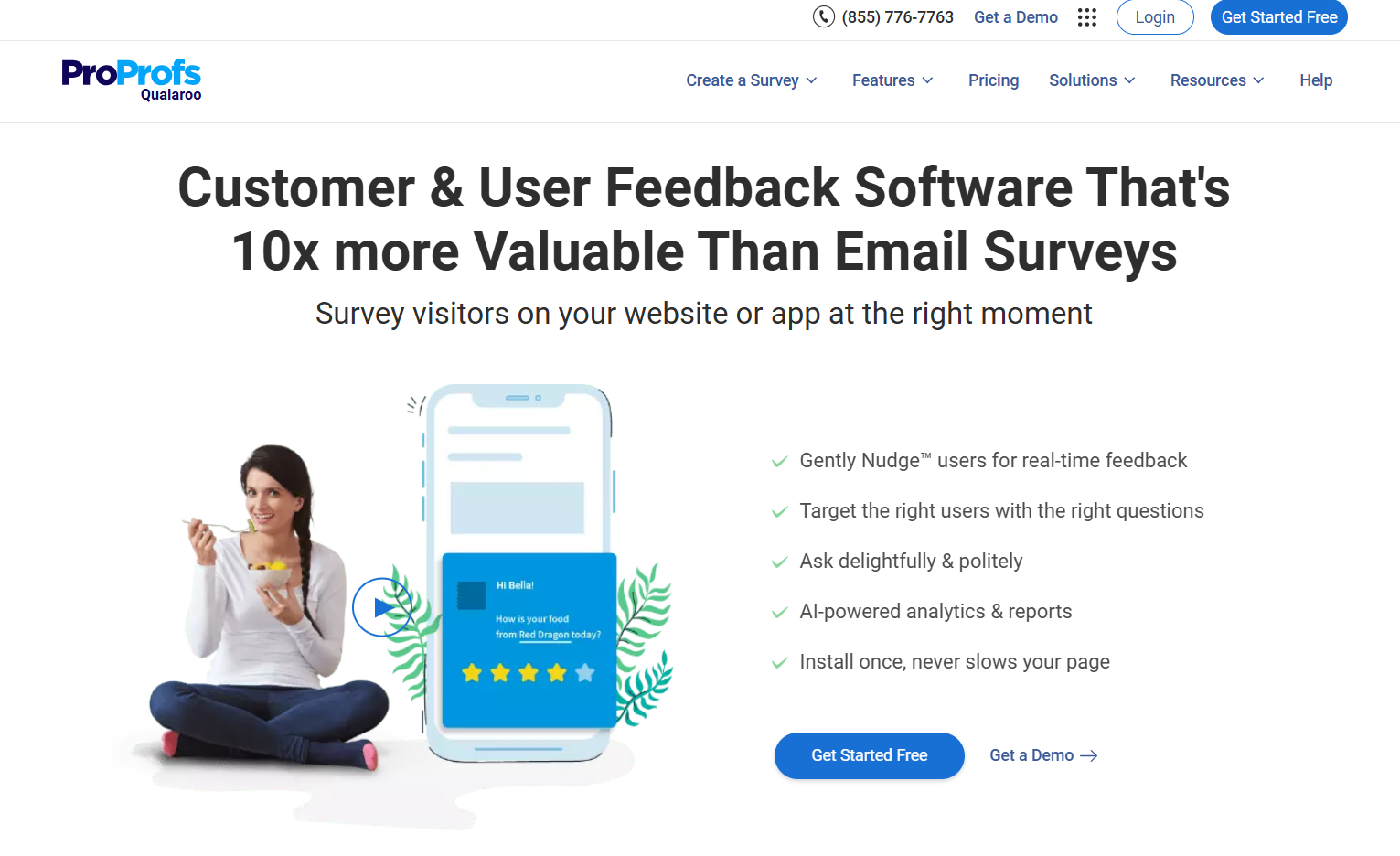
With Qualaroo, you can survey website visitors, users, or customers on your website or app. You can segment the traffic to ask the right questions to the right people at the right time.
Features:
Survey templates
Exit intent surveys
A/B testing
iOS and Android app feedback
Website and web app feedback
Real-time feedback responding
Pricing:
Qualaroo’s pricing is based on pageviews. On the Essentials plan, you’ll pay $0.0008 per tracked pageview.
7 best practices for enterprise feedback management
To help you manage feedback better, here are seven must-follow best practices.
1. Centralize feedback collection
Consolidate feedback from multiple channels (e.g., surveys, social media, support tickets) into a single platform to streamline organization and analysis. A centralized platform eliminates the risk of feedback getting lost across various systems and ensures all feedback is visible and actionable. It also reduces the workload for different teams by providing a unified view of customer insights. In addition, centralization helps detect recurring themes and trends faster, empowering teams to make data-driven decisions that improve customer experience and drive product innovation.
2. Automate feedback workflows
Use automation to categorize, prioritize, and assign feedback to relevant teams, ensuring prompt action on critical issues. Automated workflows improve efficiency, reduce manual errors, and help teams focus on high-impact feedback.
Key workflows to optimize include:
Feedback intake and tagging
Prioritization based on urgency and impact
Assignment to responsible teams
Notifications and follow-ups
Status updates for users
Escalation of unresolved issues
Reporting and analytics to track feedback trends and team performance
3. Segment feedback by stakeholder type
Differentiate between feedback from various stakeholder types to tailor responses and actions. Stakeholders can include customers, employees, partners, investors, and vendors.
When segmenting customer feedback, categorize by segments such as:
New customers
Power users
Churned customers
Enterprise clients
SMB clients
Free trial users
Returning customers
This segmentation ensures that feedback is relevant, actionable, and aligned with the specific needs of each group.
4. Integrate feedback with business goals
Align feedback management with overall business objectives to ensure that improvements drive customer experience and product growth. When feedback is tied to business goals, it becomes more actionable and impactful.
Examples of feedback integration:
Feedback: Customers request faster onboarding. Goal: Reduce time-to-value.
Feedback: Users request better mobile functionality. Goal: Improve mobile adoption rates.
Feedback: Employees suggest more cross-department collaboration tools. Goal: Increase internal productivity and collaboration.
Connecting feedback to goals ensures focused, meaningful improvements.
5. Use advanced analytics
Leverage tools like sentiment analysis, predictive analytics, and trend detection to extract actionable insights from large volumes of feedback.
Track product and software metrics such as:
NPS (Net Promoter Score): Measures customer loyalty.
CSAT (Customer Satisfaction Score): Gauges satisfaction with specific interactions.
Feature adoption rate: Shows which features users value.
Churn rate: Identifies at-risk customers.
Time-to-resolution: Assesses support efficiency.
These metrics strengthen feedback by providing context, revealing trends, and identifying areas for improvement.
6. Prioritize feedback by impact
Implement a system to weigh feedback based on business impact, revenue potential, or user reach. Focus on feedback that aligns with strategic goals and drives the most value.
Measure business impact using:
Revenue potential: Prioritize feedback from high-value customers or segments.
User reach: Consider how many users are affected.
Effort vs. impact ratio: Balance implementation effort with the expected outcome.
Retention impact: Address feedback that reduces churn and boosts customer loyalty.
7. Create a public roadmap
Maintain a visible product roadmap that shows users how their feedback influences your product direction, increasing transparency and engagement. A public roadmap fosters trust by demonstrating that user input shapes your development priorities.
With Frill, you can easily build a public roadmap by:
Creating idea boards for users to submit feedback and vote on ideas.
Using the status labels (e.g., “Under Consideration,” “In Development”) to show progress.
Embedding the roadmap in your product or website.
Sending automated updates to users when feedback progresses to new stages.
Frequently asked questions
Keep reading for answers to your FAQs.
1. What is enterprise feedback management (EFM)?
Enterprise feedback management (EFM) is a system that helps organizations collect, analyze, and act on feedback from various sources like customers, employees, and partners. It centralizes feedback into one platform, enabling businesses to identify trends, improve product quality, and enhance customer experiences.
2. How does EFM differ from basic feedback tools?
EFM tools are designed to handle large-scale feedback from multiple channels, unlike basic tools that focus on limited data collection. EFM solutions offer advanced features like integration with business goals, predictive analytics, and workflow automation, making them suitable for enterprise-level organizations with complex feedback needs.
3. Why is centralizing feedback important?
Centralizing feedback ensures all insights are stored in one place, reducing the risk of losing critical information. It allows teams to quickly identify trends, prioritize feedback, and take action. Centralization also streamlines processes, improving efficiency and collaboration across departments.
4. How can I automate feedback workflows?
Automation can categorize and prioritize feedback based on urgency or business impact, notify relevant teams, and send status updates to users. Frill, for example, offers tools to automate the collection, tagging, and tracking of feedback.
5. What metrics should I track to measure feedback impact?
Track key metrics like Net Promoter Score (NPS), customer satisfaction (CSAT), churn rate, feature adoption, and time-to-resolution. These metrics help contextualize feedback and identify which areas need improvement to maximize impact.
6. How does a public roadmap improve feedback management?
A public roadmap shows users how their feedback influences product development, building trust and engagement. Tools like Frill make it easy to create a public roadmap, allowing users to track progress and receive updates on their feedback.
7. What are the key benefits of EFM for enterprises?
EFM helps enterprises improve customer loyalty, reduce churn, streamline internal processes, and align feedback with business goals, driving long-term growth and innovation.
Ready to manage enterprise user feedback the right way? Check out Frill, which gives you surveys, roadmaps, announcements, and ideas in one place.